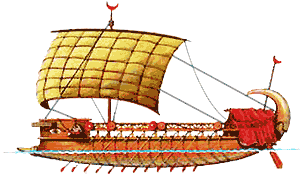EARLY SHIPS
The Phoenicians were the greatest seafaring experts of the ancient world. They built large wooden ships powered by a singled square sail laced to a mast, with a second smaller sail tied beneath it, steered by oars at either side of the stern. These magnificent ships were seen moored along the Cornish shores in 700BC as the Phoenicians sailed there to purchase tin.

The boats being built in Britain in ancient times were not as elaborate. Archaeological finds reveal that Bronze Age dwellers were constructing basic boats carved from large oak trees. The pieces were held together with wedges and stitches, and the joints waterproofed with moss. The remains of a 3,000 year old Bronze Age boat discovered in Canterbury can be seen at the Dover Museum.
When the Romans arrived in Britain they introduced Britons to the art of building large multi-purpose ships, famously huge ‘double-decker’ ships propelled by two tiers of 100 oars. The Romans had merchant ships and war ships capable of carrying livestock, soldiers, large cargoes and passengers. There's more information on the website of the Museum of Roman Shipping.
The Saxons arrived in Britain in open rowing boats propelled by about 20 rowers, steered by an oar at the stern with hulls held together by metal rivets. The best example is the famous Saxon king’s boat found at Sutton Hoo in Suffolk and you can visit the site.
The invading Vikings came in longboats designed not only to cope with long sea crossings but that were also shallow enough to travel far up inland waterways. This allowed them to transport their conquering troops far inland. King Alfred (871-901) realised that it was better to attack the Vikings before they reached land. He built his own longboats and defeated four Danish ships in a sea battle just off the Essex coast (895-897). He is credited by some as being the ‘Father of the Navy’.
As we know from history it was not enough to stop the Vikings, who were not only raiders but also great traders and explorers. After their settlement Britain became part of a great maritime trade route extending as far as the Byzantine Empire, the Islamic World, Persia and India. There’s more information at the National Maritime Museum. 
